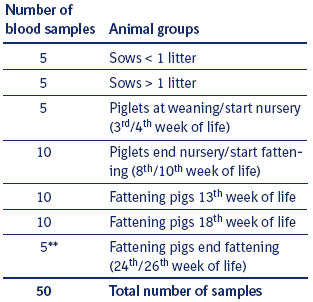2.1 How many Farms are affected and what is the prevalence in Europe?
Although it is well established that Ileitis is an important enteric disease, there is until recently a surprising lack of comprehensive and comparable epidemiological data across a wide range of European farm systems. This may partly be due to the use of different diagnostic test systems (IFA, IPMA or PCR), limited access to data and blood samples, logistic problems and the high diagnostic costs involved in profiling a large number of farms in different countries. The development of an easy to use and cost effective Ileitis ELISA (chapter 5.1.4) has opened a realistic way for the broad investigation of epidemiological factors responsible for the variation in the prevalence and severity of L. intracellularis infection in European farms. This knowledge will contribute to a better understanding of the disease and improved strategies for the prevention and reduction of economic losses due to Ileitis in Europe.
Survey design:The study is based on the cross-sectional screening of blood samples for seroconversion in European farms of different size and diverse production systems during the year 2004. In total 15,997 single blood samples from 342 European farms were analyzed by using a blocking ELISA for the detection of antibodies against L. intracellularis (Keller et al. 2004). The ELISA measures IgG serum antibodies to L. intracellularis. A positive test result reflects the exposure of pigs to L.intracellularis at least 2 to 3 weeks beforehand (Just et al. 2001; Guedes and Gebhart 2003). To ensure that all age groups are covered in the farm profile the applied sampling scheme included 50 samples per farrow to finish farm (Table 2.1a).

Table 2.1a
Number of blood samples* per age group for the farm survey.
* The statistically necessary number of pigs to detect at least one positive sample in each age group is based on prevalence values found in a pre trial with 100 blood samples per farm: Sows and fatteners 24th week ≤ 55%; Fatteners 10th to 18th week ≥ 30%; Confidence level 95%; For other farm types than farrow to finish a reduced number of age groups were included in the profile.
** In Italy an additional group of 5 pigs at the 35th week of life was included taking in consideration the longer fattening time for the Parma ham production.
All Ileitis ELISA-tests were done in the same laboratory by one technician mainly.
Farm questionnaire in the local country language was provided to the veterinarian responsible for the farm. After filling in the questionnaire, the information was checked for plausibility and both questionnaire information as well as the Ileitis ELISA data was uploaded to a database. The questionnaire included information on 74 dichotomous variables and 25 continuous variables for the following areas of interest:
- Production system and farm size
- Production figures (last 6 months)
- Current clinical signs
- Antibiotic use
- Housing, feeding, health management
- Diagnosed diseases in the last 12 months
- Current treatment and vaccination program
The farms were representative in size and production systems for the respective country.
© Boehringer Ingelheim Animal Health GmbH, 2006
All rights reserved. No part of this Technical Manual 3.0 may be reproduced or transmitted in any form or by any means, electronic or photocopy, without permission in writing from Boehringer Ingelheim Animal Health GmbH.






